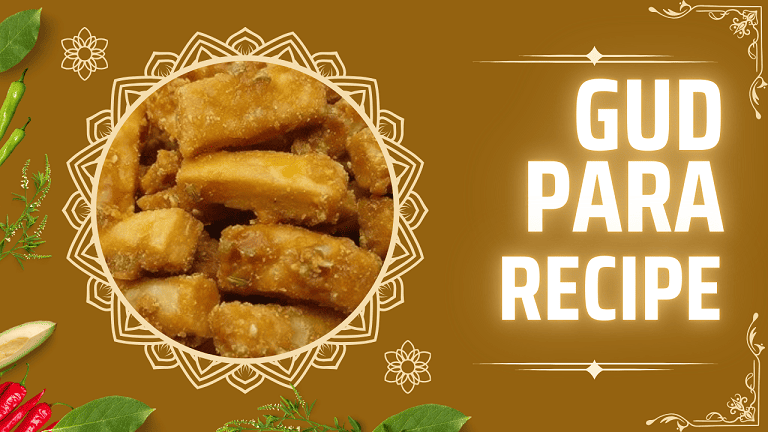Gud Para Recipe
Gud Para, also known as Gur Para or Shakkar Para, is a beloved Indian snack, traditionally made with whole wheat flour and sweetened with jaggery (gud). This crispy, bite-sized delight is commonly enjoyed during festivals such as Diwali or Holi, and often prepared in households as a nutritious treat for children and adults alike.
Gud Para has a special place in Indian cuisine due to the use of jaggery, a natural sweetener with numerous health benefits, including being rich in minerals such as iron and magnesium, and known for its ability to boost energy and aid digestion.
This recipe aims to make a healthier, more nutritious version of Gud Para by focusing on whole, locally sourced ingredients that are readily available across India.
By using whole wheat flour and jaggery, this snack is not only delicious but also provides a good source of dietary fiber, vitamins, and minerals. It is a perfect treat for anyone looking to satisfy their sweet tooth while keeping their nutrition in check.
Ingredients
For a batch of approximately 40 pieces of Gud Para, you will need the following ingredients:
Dry Ingredients
- Whole wheat flour: 2 cups (rich in fiber and nutrients)
- Semolina (suji): ¼ cup (optional, adds crispiness)
- Baking soda: 1 pinch (helps in achieving a light, airy texture)
- Cardamom powder: 1 teaspoon (for aromatic flavor)
- Fennel seeds: 1 teaspoon, coarsely ground (adds a subtle, sweet anise flavor)
Wet Ingredients
- Ghee (clarified butter): 3 tablespoons (for richness and crispy texture)
- Water: ½ cup, or as needed to form the dough
For the Jaggery Syrup
- Jaggery (gud): 1 cup, grated (unrefined and rich in minerals)
- Water: ¼ cup
- Ghee: 1 tablespoon (for glazing)
Oil for frying
- Peanut oil or mustard oil: 2 cups (for deep frying)
Instructions
Prepare the Dough
Mix the dry ingredients: In a large mixing bowl, combine whole wheat flour, semolina, baking soda, cardamom powder, and coarsely ground fennel seeds. Stir well to ensure the ingredients are evenly distributed.
Add the ghee: Pour in the ghee and use your fingertips to rub it into the dry ingredients until the mixture resembles coarse crumbs. This step is crucial for giving the Gud Para its signature crispy texture.
Form the dough: Gradually add water to the flour mixture, a little at a time, while kneading. The dough should be firm but pliable—not too soft. Knead it until smooth, then cover it with a damp cloth and let it rest for 15-20 minutes.
Shape the Para
Roll out the dough: After the dough has rested, divide it into two portions. Lightly flour your work surface and roll out each portion into a thick sheet, about ¼ inch in thickness.
Cut the dough: Use a sharp knife or a pizza cutter to cut the rolled-out dough into small diamond or square shapes, about 1 to 1.5 inches in size. Ensure the pieces are of uniform thickness to allow even frying.
Fry the Para
Heat the oil: In a heavy-bottomed kadhai or deep pan, heat the oil over medium heat. To check if the oil is ready for frying, drop a small piece of dough into the oil; it should rise to the surface slowly without browning too quickly.
Fry in batches: Add the shaped dough pieces into the hot oil in batches, ensuring not to overcrowd the pan. Fry on medium-low heat, turning occasionally, until the gud paras turn golden brown and crisp. This slow frying ensures the para is cooked evenly inside and out.
Drain excess oil: Once the paras are golden and crispy, use a slotted spoon to remove them from the oil. Place them on a paper towel-lined plate to absorb excess oil.
Prepare the Jaggery Syrup
Melt the jaggery: In a small pan, combine grated jaggery with ¼ cup of water and bring it to a simmer over low heat. Stir continuously until the jaggery dissolves completely, forming a smooth syrup. Cook the syrup until it reaches a one-string consistency (when a small drop between your fingers forms a thin string when stretched).
Coat the paras: Once the syrup reaches the desired consistency, turn off the heat. Immediately add the fried paras into the pan and gently toss them to ensure they are evenly coated with the jaggery syrup. The syrup should form a thin, glossy coating over each para.
Cool and glaze: After coating the paras, spread them out on a greased tray or plate to cool. As they cool, the jaggery syrup will harden, giving the paras a sweet, crunchy coating.
Maximizing Flavor and Nutrition
Use whole wheat flour: Opting for whole wheat flour instead of refined flour boosts the fiber content and adds more nutrients to the dish. Whole wheat flour also has a rich, nutty flavor that complements the sweetness of jaggery.
Jaggery over sugar: Jaggery is a natural sweetener made from sugarcane or palm sap. It contains more nutrients than refined sugar, such as iron, magnesium, and potassium, and provides a more complex flavor with hints of caramel and earthiness.
Cardamom and fennel: Both cardamom and fennel not only enhance the flavor of the Gud Para but also have digestive properties, making this snack lighter on the stomach.
Variations and Substitutions
Gud Para can be easily customized to accommodate different dietary preferences or ingredient availability:
Vegan Gud Para
Replace ghee with coconut oil or any other plant-based oil to make this recipe vegan. Coconut oil lends a subtle flavor to the paras, making them taste a bit more tropical.
Gluten-Free Gud Para
You can substitute whole wheat flour with gluten-free flours such as a combination of rice flour and gram flour (besan). Adjust the water content slightly, as gluten-free doughs tend to require less liquid to form a firm texture.
Baked Gud Para
For a healthier, oil-free option, bake the paras instead of frying them. Preheat your oven to 180°C (350°F), place the cut dough pieces on a greased baking sheet, and bake for 15-20 minutes, or until they are golden brown and crispy. Keep an eye on them to avoid over-baking.
Spiced Gud Para
Add a teaspoon of ground ginger or cinnamon to the dough for a warm, spiced variation. You can also add sesame seeds to the dough for an extra crunch and nutritional boost.
Serving Suggestions
Gud Para is a versatile snack that can be enjoyed in a variety of ways:
As a tea-time snack: Gud Para pairs beautifully with a hot cup of chai, making it the perfect companion for an afternoon break.
During festivals: Serve it as part of a festive spread during Diwali or Holi, alongside other traditional sweets and savories.
With milk: For a quick and nutritious breakfast or dessert, enjoy a few pieces of Gud Para with a glass of warm milk. The crunchy, sweet paras dipped in milk offer a delightful contrast in textures.
With nuts: Enhance the nutritional profile by serving Gud Para alongside roasted almonds, cashews, or pistachios.
Tips for Presentation
Rustic serving: Present Gud Para in traditional wooden or brass bowls to give the snack a rustic, festive feel. These materials also contrast beautifully with the golden-brown color of the paras.
Garnish with edible flowers: For a modern twist, garnish the paras with edible flowers like rose petals or marigold, which add a pop of color and a subtle floral aroma.
Sprinkle with seeds: For a more visually appealing and nutritious version, sprinkle some toasted sesame seeds or chia seeds on top of the paras while the jaggery syrup is still wet. The seeds will stick to the paras and provide an additional layer of crunch.
Conclusion
Gud Para is a delightful snack that combines tradition with nutrition. The use of locally sourced, fresh ingredients like whole wheat flour, ghee, and jaggery not only makes it a treat for the taste buds but also a healthier option compared to sugar-laden snacks.
By opting for jaggery over refined sugar and incorporating whole grains, you can enjoy this sweet snack without the guilt. Whether fried or baked, Gud Para offers a versatile and wholesome option that can be enjoyed by people of all ages.
This recipe ensures that Gud Para retains its traditional charm while offering a nutritious twist, perfect for festivals, family gatherings, or a simple tea-time indulgence.
Thanks for visiting Veg Recipe

